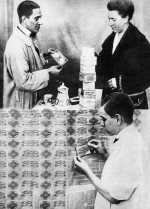1922 - 1923
Hyperinflation in Germany
Between 1913 and December 1923, retail prices increased by about 1 trillion, with inflation accelerating in 1922-1923. After World War I, the Versailles Treaty of 1919 condemned defeated Germany to pay reparations of a disproportionate amount (equivalent to two years of its pre-war GDP). The State financed these payments by creating money, which led to a self-sustaining rise in prices: as prices rose faster and faster, people sought to buy right away for fear of having to pay more later. This flight from money led to hyperinflation: prices rose faster and faster, and increased by 1 trillion between 1913 and December 1923. Gradually, the Reichsmark lost its functions as money, as evidenced by women burning banknotes to keep warm since they were worth less than wood logs. On 15 November 1923, a monetary reform broke the inflationary spiral by replacing the Reichsmark by the Rentenmark, on the basis of 1 Rentenmark for 1 trillion Reichsmark. This hyperinflation crisis also saw the rise of mass unemployment and extremist movements, in particular the Nazi Party of Adolf Hitler, which failed its attempted coup on 8-9 November 1923 in Munich.


